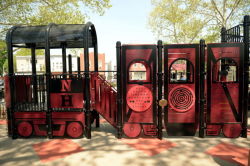Van Nest Park
Van Nest Park
Van Nest Park began as a triangle with a monument honoring World War I soldiers from the Van Nest neighborhood who gave their lives in service of their country. The granite monument, which still stands in the center of the original park, was erected in April 1926 by the Van Nest Citizens’ Patriotic League.
The Van Nest community and Van Nest Avenue take their names from the Van Nest Railroad Station, which served this area in the late 19th century. The New York, New Haven, Hartford Railroad Company established the railroad station here even before there was a settlement. The station was named by Abraham Reynier Van Nest, the director of the New York, New Haven, Hartford Railroad, in honor of his father, Reynier Van Nest, a successful saddle maker. The Van Nest family traces its roots to Pieter Pietersen Van Nest, who came from the Netherlands in 1647 to settle in the young Dutch colony.
Before 1870, this area of the Bronx was farmland, comprising the Neill farm, Round Meadow, and the Hunt Estate. In 1888, the Morris Park Racetrack was built as the premier racetrack of the region. Between 1889, when the first race was held at the Morris Park Racetrack, and 1903, when the racetrack closed, the Van Nest Railroad Station served as the main depot for visitors to the racetrack. In 1892, a Land Improvement Company surveyed and divided the farmland surrounding the racetrack into 1,700 lots for development, and gave the real estate project the name “Van Nest Park.” In part because the Van Nest name was so well known and in part because the area was accessible by rail, the region was settled rapidly; the growing community adopted the Van Nest name.
In August of 1913, the City of New York acquired the parcel of land, bounded by White Plains Road, Unionport Road, and Mead Street, on which the monument now sits. In April of 1922 the land was placed under Parks’ jurisdiction. By 1934, the triangular area around the monument contained Norway maple trees and a flagpole, all of which have subsequently been removed. In addition to the monument in honor of fallen soldiers, the park also contains playground equipment, installed after a parcel of land was added in 1938 to expand the park for the Van Nest community. Tributes to fallen soldiers of World War II, and the Korean and Vietnam Wars were added to the facade of the monument.
In 1997, Mayor Rudolph W. Giuliani funded a $30,000 renovation in Van Nest Park. The old playground equipment was replaced with a durable steel slide and jungle gym, and the playground was resurfaced.
Check out your park's Vital Signs
Clean & Safe
Green & Resilient
Empowered & Engaged Users
Share your feedback or learn more about how this park is part of a
Vital Park System







